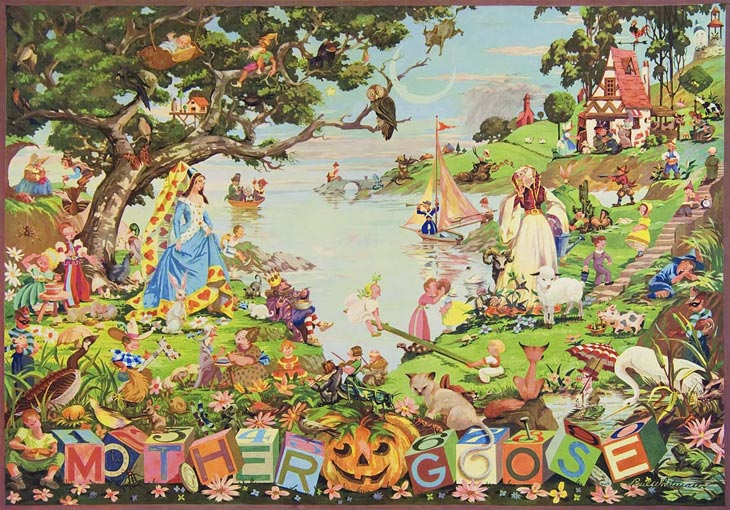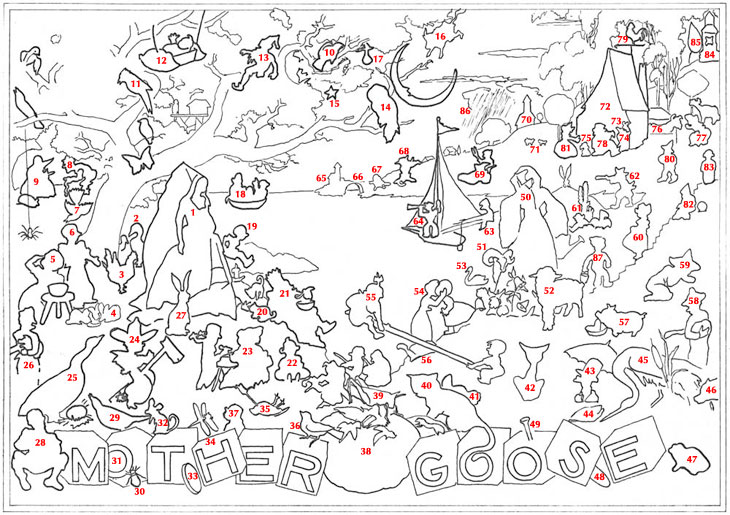
Mother Goose Composite

Mother Goose Composite Key
A Narrative to Mother Goose (Paul Whitman,
c.1948)
Everyone of us is well acquainted with the rhymes of Mother Goose, yet
nobody knows just who this wonderful character was or when, if at all, she
came into being. The earliest recorded mention is to be found in an early
French poem of 1860.
- But the joyous theme in use,
- Like the tale of Mother Goose,
- In myth and fable so abounds,
- It quite bewilders and confounds.
Each and every one of these quaint rhymes and jingles seem to have its
own special history and as we delve into the subject we can easily bring
to mind the many generations of children, yes and adults too, who have found
amusement and instruction in the many little characters who have been brought
to us out of the past.
The subject of Mother Goose is anything but an exact science. There are
many, perhaps hundreds, of modern Mother Goose books and the casual comparison
of any two of these books will show that there are characters in one that
do not appear in the other and that even the rhymes and jingles themselves
have been changed at the whim of the author. There are, however, many, many
of the better known stories which have remained constant throughout the
years and the contribution of Paul Whitman, the artist who painted the Mother
Goose painting, has been to bring all of these well known characters into
a single landscape at one time. So far as we know this has never been done
before and the value of this work to the child and to the teacher, becomes
at once apparent. Heretofore "Little Miss Muffet" has been isolated
and apart from "Little Tommy Tucker" or from
"Jack and Jill", now they become, for the first time, a member
of a large and fascinating family—all gathered in one spot and each engaged
in the particular activity for which he or she is famous throughout the
world.
To be of assistance to the busy teacher and to the child, and to help
her to identify (each and every) character that has been depicted in the
painting we follow with a brief description of the entire painting, and
as the various characters are named, the first line of the rhyme in which
they are found will be added. There are a few cases in which one character
may be called upon to represent more than one rhyme—this was, in part,
unavoidable but in all cases the better known rhyme is illustrated.
Starting with the large central character on the left center—this is
(1) the Queen of Hearts who baked the tarts. Behind the Queen of Hearts
is (2) the Duck from A Little Man and below the Duck is (3) the Black Hen
(Hickety, Pickety My Black Hen) who lays eggs for gentlemen. Below the Black
Hen are (4) the Three Blind Mice and to the left we find (5) Little Miss
Muffet chasing the spider away. Next to her stands (6) Little Tommy Tucker singing for his supper. Above Tommy's head is (7) the Thrush
which sang the psalm in Who Killed Cock Robin? Above the Thrush is (8) the
Crooked Man talking to (9) the Old Woman under a hill. This picture of the
Old Woman could really represent three other rhymes all about old women—
"There was an old woman, and what do you think"; "There
was an old woman, a I've hear tell"; and "There was an old woman
lived under a hill. She put a mouse in a bag"—you see they are really
all very much alike, aren't they?
The birds in the big Oak come from two different rhymes—and the Black
Birds (10 and 11) obviously may be recognized from "Sing a Song of
Sixpence" and the other birds take their parts in "Who Killed
Cock Robin?" Swinging high up in the tree is (12) Rock-a-bye, Baby,
On the Tree Top, and to the right, watching the baby, is (13) Old Man Whiskum
Whiskum Wheeze who lived way up in the top of the trees. Far out on the
limb is the (14) Wise Old Owl who sees everything that goes on below. On
one side of the Owl is (15) the Star from "Twinkle, Twinkle, Little
Star" and on the other side is the Moon which (16) the Cow is jumping
over from "Hey, Diddle, Diddle." Also in the tree is (17) the Pear
from "I Had a Little Nut Tree"—seems funny to have a pear growing
on an oak tree but that's the way it was that day.
Going back to the Queen of Hearts, just on the right of her head are (18)
the three men in a boat (Rub-a-dub-dub) and Three Wise Men from Gotham—below
them is (19) Jack Be Nimble in track suit for jumping over his candle. Below
Jack are (20) the Three Little Kittens Who Lost Their Mittens, playing next
to (21) Old King Cole (was a merry old soul)—he's got his pipe in one hand
and his bowl on his knee. His three fiddlers are down by his feet, too.
Below Old King Cole is (22) "There was a little girl who had a little curl, right
in the middle of her forehead" and on her right sits (23) Mr. and Mrs.
Spratt (from Jack Spratt Could Eat No Fat). Over to the left of Mr. Spratt
is (24) "Ride a Cock Horse," then (25) the Goose that laid the
golden egg from Aesop and then comes (26) "Tom, Tom, the Piper's Son"
who is caught in the act of stealing the pig. We musn't forget (27) the
Easter Bunny that sits just below the Queen of Hearts.
Starting at the lower left-hand corner and working across the entire
bottom of the picture we find first, (28) "Little Jack Horner sat in
a corner." On the "O" in MOTHER sits (29) the Lark and at
the base of this "O" is (30) the Beetle, both from Who Killed
Cock Robin? This same "O" has (31) a clock on its face and
(32) the mouse from "Hickory dickory dock" sits on the number 3.
At the base of the 3 is (33) the sixpence from "Sing a song of sixpence".
Above the "H" in MOTHER is (34) the fly; above the 4 is (35) cock-robin
and on the 5 is (36) sparrow—all from Who Killed Cock Robin?
Above the "H" is (37) the head of a dog who is really not from
Mother Goose at all but who belongs to my grandchildren and they really
wanted him included. His name is "Doonie."
On top of (38) the pumpkin from "Peter, Peter, pumpkin eater"—this
could also represent the Halloween Pumpkin—is (39) the grasshopper and
the ant from Aesop's fables. To the right of the pumpkin is (40) a pussycat
(Pussycat, pussycat, where have you been?) whose tail forms the first "O"
in GOOSE. Right above the cat, who by the way represents many other little
rhymes about cats, we find (41) the beaver from "Two little beavers".
Next to the beaver sits (42) the fox from one of Aesop's fables and he's
probably watching that fat piggy, don't you think? Next to the fox is (43)
"Doctor Foster went to Gloucester" and isn't that the best umbrella
you ever saw? Just below the doctor is (44) the fish from Who Killed
Cock Robin? and next to the fish we find (45) the crane and (46) the
wolf, both from Aesop. Down in the right-hand lower corner is (47) the frog
from "A frog, he would a-wooing go" and underneath the "S"
in GOOSE is (48) the dollar from "A diller, a dollar." The blocks
spell out MOTHER GOOSE as you can see and the numerals from 1 to 9 are on
top. Through the 8 is (49) the nail from "For want of a nail."
Now let's go to the other main figure on the right. This is (50) "Mary,
Mary, quite contrary" but it could also be used to represent Mary from
"Mary had a little lamb"—both of there girls were named Mary
and it could have been one girl. Underneath Mary's right arm you can see (51
& 52) the black sheep from "Baa, baa, black sheep," and out
in the water is (53) the Swan from "Swan swam over the sea,"
and next to the Swan is (54) "Georgie Porgie, puddin and pie"—he's
kissing one of his girls. And there's (55) "Seesaw Margery Daw"
and do you see that the seesaw is on the back of (56) the turtle from Aesop?
Over next to the Little Lamb is (57) "This little piggy went to market"
and to our right is (58) "Taffy was a Welshman" who is stealing
the piece of beef. Do you remember another boy who is dressed just as Taffy
is? Above Taffy is (59) "Little Boy Blue, come blow your horn"—we
all know about him.
Starting at the bottom of the steps is "Jack (87) and Jill (60)
went up a hill" and pretty soon they are both going to fall down the
hill. Above Jack is (61) "There was a man in our town" who is
jumping into the briar bush and above him is (62) the man with the gun—he's
aiming at the rabbit and this is all told in "Bye, baby bunting."
On Mary's right there is (63) "Simple Simon, met a pieman" and
he's fishing in the pail which seems sort of foolish when he could be fishing
in the ocean, couldn't he? In the boat next to Simon is (64) "Bobby
Shafto's gone to sea."
Way out in the ocean there is (65) the Lighthouse and then comes (66)
"London Bridge is falling down" and then comes (67) the dish running
away with the spoon and (68) the cat who is fiddling—these are both from
"Hey, diddle, diddle". On the shore above the boat is (69) the
old woman with all her children from "There was an old woman who lived
in a shoe." Above the old woman, in the background is (70) the church
from "Here is the church" and in the meadow in front of the church
are (71) the sheep that have been lost by Little Boy Blue.
The (72) big house in the upper right-hand corner and most of the people
shown there are connected with "This is the house that Jack built."
If you look around there a bit you will find (73) the malt, the rat, (74)
the cat, (75) the dog, (76) the cow with the crumpled horn, (77) the maiden
all forlorn, (78) the man all tattered and torn, (83) the priest all shaven and
shorn, (79) the cock that crowed in the morn and (80) the farmer sowing
his corn. They all come from one story. In the house too you should see
(81) "Mother Hubbard" looking in her cupboard. We almost forgot
to mention (82) the boy sitting on the steps studying from his school book—he
has the alarm clock next to him—surely you know that he is "A diller,
a dollar."
Way up in the top right-hand corner is (84) the well with pussy in it—that's
from "Ding, dong, bell"—and sitting on the wall—no, I'm not
going to tell you who he is as I know you know all about him (85). By the
way, the rain cloud (86) behind the church represents many different rhymes,
one of which is "Rain, rain, go away."
Now, we have told you all about the principal characters that are shown.
You read your Mother Goose Book and you will read of many more and if you
look at the painting I am sure you can find them. It's a game to play and
it's fun too.

